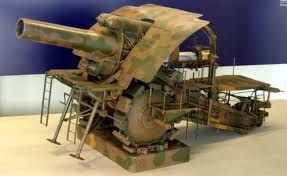
Big Bertha Krupp Howitzer deployed in 1914.
Model in the Paris Army Museum.
Worth the read, from Wiki:
It had its genesis in the lessons learned by the Germans (and Austrians) from the Russo-Japanese War of 1904–1905. During the war, the Japanese had dismounted some of their coastal defence 28-cm howitzers and used them to help break their siege of the fortified Russian naval base at Port Arthur. This was a complete novelty as, until that time, it had been assumed by military experts that the largest transportable siege guns were around 20 cm in calibre. Nevertheless, most Europeans completely failed to draw the lessons the Japanese had taught — apart from, as mentioned, the Germans and Austrians (the latter also developed a series of road-mobile superheavy guns, including the 30.5-cm Schlanke Emma howitzer, the 38-cm Barbara and Gudrun howitzers, and their own 42-cm howitzer).[7]
During the early 1900s, therefore, Krupp began to develop a series of road-mobile heavy mortars and howitzers, ranging from 28 cm calibre to 30.5 cm. These, in turn, built upon Krupp's experience with building coastal defence mortars (Küstenmörser), such as the 30.5-cm Beta-Gerät, the first model of which had been introduced in 1897 (though other nations, including Britain and the United States, also built similar weapons).[6]
A new version of the 39.5-cm Beta-Gerät howitzer, vastly superior to the 1897 model, was developed in 1908, but finding it wanting in offensive power, the APK (Artillerieprüfungskommission, or "artillery testing committee") asked Krupp to build a larger gun capable of smashing modern fortifications. Krupp first investigated the possibility of building a 35-cm weapon, but instead jumped to 42-cm as this was the smallest shell that could carry the large bursting charge required to fulfil the APK's requirements. The first 42-cm design was the massive L/16 (the barrel was 16 calibres in length) Gamma-Gerät howitzer, which was basically a scaled-up version of the Beta-Gerät.[6] Unusually for Krupp, both the Beta and Gamma weapons eschewed the usual sliding-wedge Breech mechanism in favour of a screw-type breech, after the practice common in Britain and France.
Gamma fired shells weighing up to 1,160 kg. It weighed 150 tons, and was what the Germans called a Bettungsgeschütz, or "bedding gun", i.e., it was mounted on a stationary carriage that was emplaced in a concrete foundation, which took days to prepare. It had to be transported in sections on ten railway cars — six for the gun and another four for the bedding.
Moving Gamma and preparing it to fire required significant resources. Consequently, the APK asked Krupp for a more mobile version, and ordered one gun on 15 July 1912.[6] Even before it was delivered in December 1913, the APK went ahead and ordered a second example in February 1913. The first howitzer was demonstrated to Kaiser Wilhelm II in March 1914, who was greatly taken by the new weapon, and the second was delivered in June 1914.[6]
The new howitzer was a road-mobile weapon mounted on a two-wheeled field type carriage of conventional, if massive, construction. It was a completely different weapon from the Gamma-Gerät. The barrel was shorter than Gamma's by 4 calibres length, and reverted to the conventional Krupp sliding-wedge breech. With thinner walls, the barrel was of generally lighter construction than Gamma's and fired lighter shells of around 830 kg. Fully assembled it weighed 43 tons, much less than Gamma, and did not have to be emplaced in concrete. Special steel "mats" were developed, onto which the wheels were driven, with a steel aiming arc at the rear of the carriage that allowed limited traverse. This aiming arc was fitted with a massive "spade" that was buried in the ground and which helped anchor the weapon. To prevent the weapon bogging down in muddy roads the wheels were equipped with Radgürteln, pedrail bands with feet to spread the load. Krupp and Daimler developed a tractor for the Bertha, though Podeus motorploughs were also used to tow the guns, which were broken down into five loads when on the road.[6]